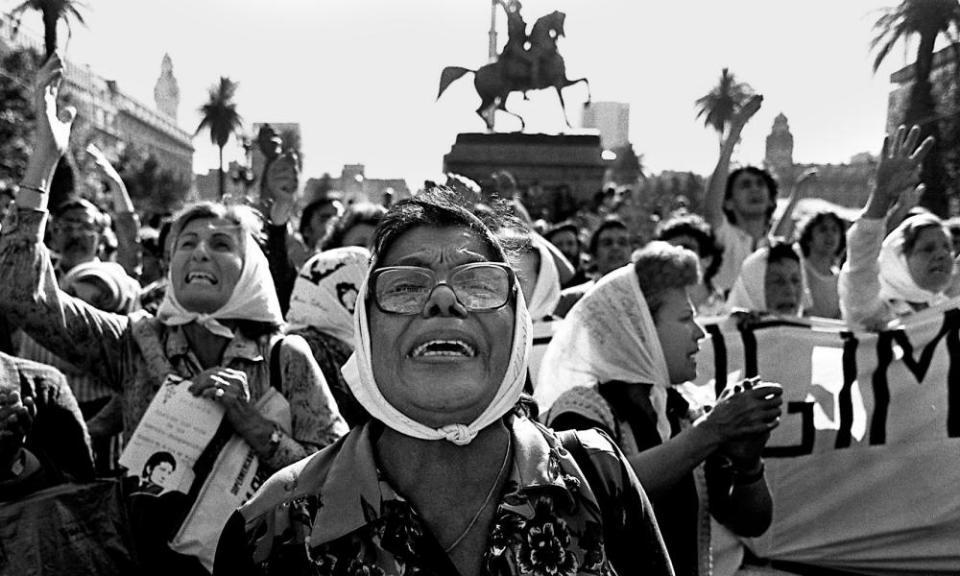Hebe de Bonafini obituary

A line of heavily armed soldiers guarded a presidential palace. Opposite them, walking silently in a circle, wearing their trademark white headscarves, was a group of mainly middle-aged women, and prominent among them was Hebe de Bonafini.
In the late 1970s and early 80s, Argentina suffered under a military dictatorship that kidnapped, tortured and murdered several thousand of its own citizens. Anyone who protested was likely to find themselves a victim of the repressive regime.
At the time it seemed as though these Mothers of the Plaza de Mayo, walking in the square in front of Argentina’s presidential palace in Buenos Aires, were among the few who were brave enough to stand up for respect for the rule of law and basic human rights.
De Bonafini, who has died aged 93, was one of the founders of this movement, following the disappearance of her two sons, first Jorge and later Raúl, students and leftwing militants. When her attempts to discover what had happened to Jorge brought no results, in April 1977, at the height of the repression unleashed by the military dictatorship in what it termed the “dirty war” against “subversives”, she and 13 other mothers facing a similar loss joined together to form the Association of Mothers of the Plaza de Mayo.
The dangers this presented were soon made obvious when three of their members joined the list of those “disappeared” by the security forces. But De Bonafini and the others pressed on, and soon began their weekly Thursday walk in the square in front of the Casa Rosada presidential palace. The movement gradually grew in strength, with many more mothers, grandmothers and relatives of the disappeared joining in.

Hebe was born in a working-class neighbourhood of the small coastal town of Ensenada, on the outskirts of La Plata, the capital of Buenos Aires province. She was the daughter of Francisco Pastor, who worked in a hat-making workshop, and his wife, Josefa Bogetti. In 1949 she married a local man, Humberto Bonafini, with whom she had three children, Jorge and Raúl, and a daughter, Alejandra.
Her life changed abruptly following the military coup in March 1976 that ousted Isabel Perón. In February 1977 De Bonafini learned that Jorge had been forcibly “disappeared”, rounded up by the security forces. She immediately began her search to discover what had happened to him.
That April she joined with other mothers in the Plaza de Mayo, and they began to share information and to try to break the silence surrounding the gross human rights violations being committed by the dictatorship. In December of that year, five of them were abducted. As De Bonafini later recalled: “When those mothers were taken, many of the families told us: ‘Stop, you’ll all be killed, you’ll never reappear.’ It was a battle against our own families, because fear is a prison, but we never thought of giving up.”
In the same month, Raúl was also taken, and never heard of again. And a few months later, María Elena Bugnone Cepeda, who had been Jorge’s partner, suffered the same fate.
The mothers continued their weekly silent protest throughout the years of the dictatorship, winning widespread support in Argentina and internationally. The activity continued after the return of civilian rule in 1984, as the Mothers still wanted to know exactly what had happened to their loved ones, their slogan being: “They were alive when they were taken, we want them back alive.”
In 1986 came a split within the association. One group wished to accept help from the by then democratically elected government. De Bonafini was against this. She saw the Mothers’ struggle as a political one, calling for change in Argentina to keep the faith with her children.
This led her to become an often strident opponent of the governments in power, especially that of Carlos Menem in the 1990s, when he brought in a pardon for the military commanders who had been at the head of the dictatorship and followed what she saw as rightwing neoliberal economic policies that hurt ordinary people.
When the leftwing Peronist Néstor Kirchner was elected president in 2003 and repealed the pardons, De Bonafini declared: “The enemy isn’t in government any more.” She became a supporter of him, and subsequently of his widow, Cristina Fernández de Kirchner, who is now Argentina’s vice-president.
In her later years she sparked controversy because of her outspoken views. She outraged many when she welcomed the 11 September 2001 attacks, arguing that it was good for the US to experience some of the pain it had inflicted on other countries. She also upset many when she declared that Pope Francis should “burn alive in hell” for what she saw as his failure to speak out against the dictatorship when he was the Jesuit provincial in Argentina. Despite this, to the end she remained an inspiration for calling repressive regimes to account through non-violent resistance. Humberto died in 1982.
She is survived by Alejandra.
• Hebe María Pastor de Bonafini, campaigner, born 4 December 1928; died 20 November 2022

 Yahoo News
Yahoo News 
